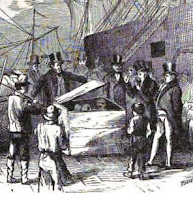Little Murders
(From
Cincinnati Daily Gazette , Cincinnati, Ohio, December 27, 1870)
 The Hamilton Murder.
A Most Mysterious Tragedy.
Special Dispatch to the Cincinnati Gazette.
The Hamilton Murder.
A Most Mysterious Tragedy.
Special Dispatch to the Cincinnati Gazette.
Hamilton, O. December 26.
The murder of Thomas Meyers, in George Johnson’s saloon, in this city last Saturday night, is almost the only topic of conversation here now. The circumstances of the tragedy are so very peculiar that no one knows exactly what to make of it. The murder occurred in a room over the saloon used as a faro bank, but in which were also several card tables, employed at times by those who wished to enjoy a quiet game of cards for amusement.
In this room, where the affair occurred, were gathered several of our prominent citizens among whom were Co. A. C. Sands, Job E. Owens, Dr. Huber, Peter Schwab, David E. Brown, John McKinney, E. Bannister, J. C. Lindley, Samuel Davidson, Solomon Schurz. Colonel Sands says, however, that hi had left the room before the shooting occurred, although he was there but a short time before. Of all those who were present, no one but Peter Schwab can give an intelligent account of what happened, and his statement is singularly deficient in some important particulars.
He says that he and Dr. Huber were playing casino at one of the tables. Colonel Sands and three others were playing seven-up at another, while Meyers and a number of others were engaged at the faro bank, George Johnson, the proprietor, dealing the same.
Of a sudden he heard the cry, “Oh, murder,” and looking up saw Meyers fall against the wall and sink toward the floor. As he slipped from his seat he discharged a revolver, the bullet lodging in the wall over the faro table. As he reached the floor he fired again, the ball being imbedded in the wash board just above the floor. At the cry of “murder” the room was cleared in a jiffy, only Schwab and Bannister remaining. Seeing that Meyers was badly hurt, Schwab ran out upon the street, captured Dr. Huber and brought him back, who examined Meyers’ condition. He found that Meyers had received a pistol shot in the abdomen which had severed an important artery, and death ensued in a few minute. In addition to this wound he had received three blows upon the head, evidently made by a slung-shot, either of which would have proved fatal.
Now, what is particularly curious about the affair is that no one saw the man enter and deliver the blows upon Meyers’ head and no one heard the report of the pistol when he was shot. The first circumstance which attracted attention was the cry or “Oh, murder.” Of course, under these circumstances, it is very difficult to fix upon any one as the perpetrator of the deed. Suspicion rests, however upon Tom McGehen, a man who has had a deadly quarrel with Meyers for some time past. A boy stated that, shortly before the occurrence, he saw Tom McGehen, his nephew, James McGehen, Jack Gavin, Daniel McGlynn and Ich Sheely pass through the saloon below, and go to the card room. Upon this statement a warrant was sworn out or the arrest of these parties. This morning, however before the warrant was served, they learned that it had been issued, and voluntarily surrendered themselves to esquire Wilkins. Upon representations made by the defenders that the presence of witnesses from abroad was necessary to their defense, they were placed in charge of a constable and sent to the Hamilton House to be kept until Wednesday morning when the preliminary examination will take place.
"The Hamilton Murder."
Cincinnati Daily Gazette 27 Dec 1870
.


























































.jpg)











